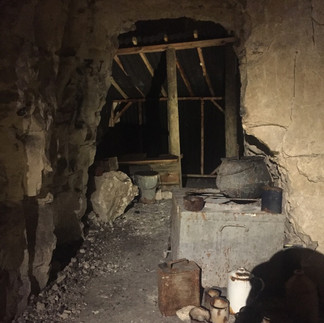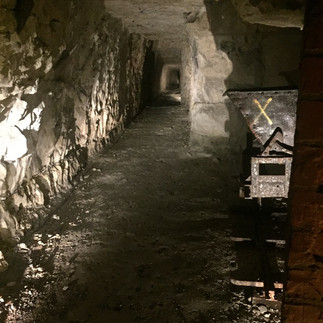Kiwis at the Western Front - Day 2
- Alan
- Jun 11, 2022
- 9 min read
We hit the road early on our second and final day, this time staying inside French borders, but once again focussing on New Zealand’s involvement on the Western Front.
Our first day had been mainly cloudy with some late sun, but we experienced blue sky and sunshine on the second day which accentuated the beautiful spring countryside of NW France.
Longueval
The town of Longueval, one hour south of Lille, holds a special place in New Zealand's military history. It was near this place on Friday, 15 September 1916, that the New Zealand Division joined the (now infamous) Battle of the Somme.
New Zealand troops arrived in France in May 1916 after service in Egypt and Gallipoli. Made up of veterans of these two campaigns and reinforcements from New Zealand, the New Zealand Division trained, and fought in the country around Armentieres before moving into place in early September as the battle entered its third month. First into action was the New Zealand Field Artillery.
For the New Zealanders it was a grim prospect. From their positions, to the right lay Longueval Village and Delville Wood. To the left lay High Wood and the New Zealanders had to advance up a slope towards formidable German positions on a ridge line ahead of them, swept by machine gun and artillery fire.
By 6am on the 15th soldiers had had breakfast and a tot of rum. The Division's official history records a "ghostly pallor was creeping into the sky .. the weather held out every prospect of a fine day." Precisely at 6.20am the guns roared into life and the leading waves of infantry, from the Auckland and Otago regiments went "over the top into action". Each soldier was in light fighting order, with 200 rounds of ammunition and two hand grenades, rations and gas masks, with rifles and bayonets.
Eight companies advanced across open land between shell holes behind a ferocious artillery barrage that crept ahead of them at the rate of around 50 metres per minute. It was a bitter hand-to-hand fight, with rifle and bayonet, but by 6.50am, the German trench line was in New Zealand hands. The advance continued and by late afternoon, the Division had achieved all its objectives, forcing back the enemy and clearing the village of Flers.
Over the ensuing days, as they attempted to first hold their ground and then advance further, rain swept the battlefield reducing the topsoil to cloying mire and filling shell holes with water. Corpses littered the battlefield and the stench of death lingered over all.
Twenty-six-year-old Sergeant Donald Forrester Brown, of the Otago Regiment, won the Division's first Victoria Cross, the highest award for gallantry in New Zealand and the British Commonwealth. Three times he charged and destroyed enemy strongpoints. He was killed in action just three weeks later….
On that first day, 6000 soldiers from the New Zealand Division joined the attack. They paid heavily with 600 killed (including 52 members of the Pioneer Battalion and the Maori Battalion) and 1200 wounded or missing.
Again we were struck by the beauty that surrounded us at the Longueval Memorial which is basically a ring of grass bordered by a low hedge with the Memorial in the middle. It is surrounded by fields and during our visit, three tractors were busy ploughing the fields getting ready to plant spring and summer crops. Apart from their sound, there was peace all around - a far cry from that morning nearly 106 years ago.
In total, more than 2000 New Zealand soldiers lost their lives on the Somme in the autumn of 1916 and about 6000 more were wounded. Most of the dead have no known graves and today more than 1200 of them are commemorated on the Caterpillar Valley (New Zealand) Memorial to the Missing which sits within Caterpillar Valley Cemetery.
Caterpillar Valley Cemetery
Just five minutes from Longueval is the Caterpillar Valley Cemetery, which contains the graves of 5,197 United Kingdom, 214 New Zealand, 98 Australian, 19 South African, six Canadian and two Newfoundland soldiers.
On the Wall of Remembrance there, are the names of 1272 New Zealanders lost during the fighting of 1916 and whose graves are not known. It also contains the grave from which the remains of an unknown New Zealand soldier were exhumed and re-interred in solemn ceremony at the National War Memorial at Wellington, New Zealand in 2004.
Again the beauty of the landscape with blue sky and sunshine and the blooming flowers of the spring of 2022 was just breathtaking – all lost among our thoughts of the events of over 100 years ago.
Arras and a Surprise!
Our next stop was the Carrière Wellington Museum, (www.carrierewellington.com) in the city of Arras, which consists of a visitor centre displaying historic artifacts and presenting the historical context of the Battle of Arras in April 1917, including the work of New Zealand tunnellers and the military strategy that underlay the tunnels' construction.
The New Zealand Tunnelling Company were the first New Zealanders to reach the Western Front. The company was formed in 1915 from quarrymen, gold miners from Hauraki, labourers from the Railways and Public Works departments and West Coast coal miners. They arrived in France in March 1916.
Initially the company was involved in successful ‘counter-mining’ efforts just to the north-east of Arras, which involved tunnelling to identify and destroy the tunnels the Germans were mining towards the Allied front line.
In November 1916, the tunnellers moved to Arras itself. Over the following five months they completed two vast quarry and tunnel networks, running from the centre of Arras to near the German front line.
The complex system consisted of facilities capable of housing 20,000 people, including galleries, subways, kitchens, headquarters and a hospital with operating theatres and a mortuary. The tunnels were fitted out with running water, electric lights and a light-rail system.
In all the tunnellers dug 8 kilometres of tunnels. The work was carried out 24 hours a day, seven days a week, with individual tunnellers doing eight-hour shifts followed by 24 hours rest.
To help the tunnellers find their way underground, the locations in one of the systems were all given New Zealand place names, from Bluff at one extremity to Russell at the other. Godley Avenue, named after the New Zealand Expeditionary Force commander, Sir Alexander Godley, linked the locations. Another tunnel system was given British place names.
The New Zealanders also left graffiti on the walls, including a large ‘Kia Ora’ (a Māori greeting) flanked by ferns.
Once the tunnels were completed in early April 2017, over 24,000 British soldiers entered and spent a week down there living cheek by jowl. At 5.30am on 9 April 2017, the soldiers erupted from the tunnels (see last picture below) taking the German front lines by surprise marking the start of the Battle of Arras which mobilised forces from across the Commonwealth.
The battle, as in many WW1 conflicts became a costly stalemate for both sides and by the end of the battle some five weeks later, the Allies had suffered about 160,000 casualties and the German Army about 125,000.
The Museum itself, contains a room with various static and interactive displays about the tunnels and the Battle of Arras but the highlight is the guided tour of the tunnels themselves.
The tunnels are accessed via a lift shaft and we were taken approximately 22m (70 ft) under the ground inside the galleries of the underground quarry. I learned about the development of the strategy of the Battle of Arras, and also the daily life of the New Zealand tunnelers and the soldiers of the British Expeditionary Forces sent in these tunnels to prepare for the battle.
It was a completely fascinating tour. I was the only Kiwi among the 20 participants and rightly felt a huge sense of pride as the tour ensued. Yes, I had driven through the Arras Tunnel underneath the National War Memorial in Wellington but had little or no knowledge of the story behind it – no longer!
Le Quesnoy
Our final stop of the day was an hour away - the small town of Les Quesnoy (pronounced le-ken-wa)
This town was in German hands for almost all of the First World War, from August 1914 until New Zealander soldiers liberated it on 4 November 1918.
But like with many things Kiwi, this was no ordinary liberation! I’ll pass it over to Lieutenant
Leslie Cecil Lloyd Averill the Intelligence Officer of the 4th Battalion, 3rd New Zealand (Rifle) Brigade to tell you the story….
“The time was approximately midday [on 4 November 1918] and we still had not gained entrance into Le Quesnoy. We were, however, making progress and the German fire-power from the walls had lessened. There were two outlying bastions ... Fortunately the possibility of wall climbing had been foreseen and a ladder had been provided by the engineers ... The CO was anxious that these bastions should be explored and so, with 5–6 men, I put the ladder against the wall, we climbed it and drew up the ladder behind us ... We took the ladder down on the third and sloping grassy side of this first bastion only to find a similar fortification straight ahead of us. The wall climbing of this second bastion had to be repeated and from the top of this outlying rampart I could see that we could now approach the main and final wall of this well-fortified town ... The 30-foot ladder was too short to reach from the bottom of the moat to the top of the final wall but there was one place where the ladder could be placed to reach the top. This was on a narrow stone bridge, about a foot wide, which spanned the moat and was connected with a sluice-gate ... After crossing this bridge and sluice-gate a narrow ledge ran for some 10 yards beside the wall to an arched opening, giving entrance to the town, but which – needless to say – had been completely blocked by the enemy to deny us access through the wall. It was only on this narrow wall above the sluice-gate that the ladder could reach the top.
After a council of war with his battalion commander, Averill returned to the spot with an assault party. The official history later recorded how Averill and another lieutenant worked their way back to the sluice-gate.
“The whole place was ominously still but for the gurgle of water in the moat below them ... Quietly they raised the ladder against the wall. It reached the top of the bricks with a foot to spare, resting against a 2-foot-high grassy bank which crowned the rampart ... Two of the riflemen steadied the ladder on its insecure perch and Averill started to mount it, telling the others that he would shout down to them from the top if all was quiet ... Averill quickly reached the top of the brickwork and stepped over the coping onto the grassy bank. Crouching behind it, he peered over. It was one of the most dramatic moments in the Division's history”
Averill recalled that the Germans soon:
…”threw up the sponge ... After being under the heel of the Hun for four years, the delight of the people of Le Quesnoy on being free again knew no bounds. That their liberators had come from the other side of the world to help them in their hour of need impressed them very greatly and this battle, in which 90 of the NZ Division gave their lives, was a sacrifice which will never be forgotten”.
So there you go – the #8 wire Kiwi solution to a problem!
Averill maintained a close association with Le Quesnoy for the rest of his life and the town's primary school (l'Ecole du Lieutenant Averill) is named after him.
When I was drawing up our itinerary, Le Quesnoy shaped as the highlight. I knew of the story and given the themes of our two days was following in the footsteps of New Zealand troops, I was excited as we drove into the small town.
The town itself has a lot of New Zealand associations. Street names such as Rue Nouvelle-Zelande, Rue Aotearoa, and Place Des All Blacks as well as Le Maison Quercitaine de Nouvelle-Zelande a small shop exhibiting documents, photographs and other memorabilia relating to the New Zealand involvement in fighting in the area - which unfortunately was closed on the day of our visit! Most shops had window stickers welcoming New Zealanders and it was clear that this town and my wonderful country 12,000 miles away are intimately connected
We visited the sculptured plaque on the rampart of Le Quesnoy – quite different to the other three New Zealand memorials we had seen. It is set into the rampart and can be viewed from a position opposite the now empty moat and over a narrow bridge where the New Zealanders set up their ladders.
The most exciting future development is the establishment of a New Zealand War Memorial Museum in Le Quesnoy to be opened on ANZAC Day 2023 and the relevant information, including a more in depth description of the Le Quesnoy story can be found at this link
A New Zealand Herald Article published on ANZAC weekend 2022 is also a good read along with the accompanying video. https://www.nzherald.co.nz/travel/weta-to-open-blockbuster-le-quesnoy-exhibition-in-frances-wwi-battlefields/KST36TJCANANK76XGYTHLZ4CJY/
Finally, Māori Television, on their website https://www.maoritelevision.com/docos/liberation-le-quesnoy have made available (to NZ viewers only) an excellent 48 minute documentary entitled ‘The Liberation of Le Quesnoy’
The Le Quesnoy visit wrapped up our two day journey around some of the Western Front battlefields with a distinctly New Zealand focus.
Wikipedia sets out that military casualties on the Western Front from 1914 to 1918 numbered a staggering 3.5 million (dead) and 8.2 million wounded with a further 424,000 civilian casualties.
While our two days focussed on New Zealand forces, the impact of nearly 4 million dead reverberated around the world and although dubbed the ‘war to end all wars’, it wasn’t and it has been argued that the catastrophic loss of life did result in a later reluctance by countries to pursue an aggressive policy against Adolf Hitler.
Nonetheless, our two days carriey some abiding memories of the events of 1914-1918 and how these impacted upon a small country at the other end of the world. We were filled with immense pride in how our (then) very young country responded but overlaid with an incredible sorrow at the senselessness of a lot of what happened and indeed conflict itself and its impacts. As the events in Ukraine play out with horribly similar parallels to those major wars of the 20th century it is heartening to see that the sacrifices have not been forgotten and are presented in a universally sombre and appropriate manner across what was the Western Front
Lest we forget…….


























































Comments